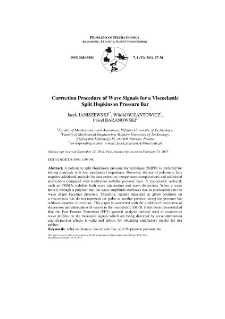Nasza Biblioteka Cyfrowa udostępnia 1 868 obiektów cyfrowych
Obiekt
Tytuł: Correction Procedure of Wave Signals for a Viscoelastic Split Hopkinson Pressure Bar ; Correction Procedure of Wave Signals for a Viscoelastic Split Hopkinson Pressure Bar
Współtwórca:
Jacek JANISZEWSKI, Paweł BARANOWSKI ; Jacek JANISZEWSKI, Paweł BARANOWSKI
Abstrakt:
A polymeric split Hopkinson pressure bar technique (SHPB) is preferred for testing materials with low mechanical impedance. However, the use of polymeric bars requires additional analysis for data reduction, temperature complications and additional restrictions compared with traditional metallic pressure bars. A viscoelastic material, such as PMMA, exhibits both wave attenuation and wave dispersion. When a wave travels through a polymer bar, the wave amplitude decreases due to attenuation and the wave shape becomes distorted. Therefore, signals measured at given positions on a viscoelastic bar do not represent the pulse at another position along the pressure bar without complex corrections. This paper is concerned with the problem of correction of dispersion and attenuation of waves in the viscoelastic SHPB. It has been demonstrated that the Fast Fourier Transform (FFT) spectral analysis method used to reconstruct wave profiles on the measured signals which are being distorted by wave attenuation and dispersion effects is valid and allows for obtaining satisfactory results for tire rubber.
;
A polymeric split Hopkinson pressure bar technique (SHPB) is preferred for testing materials with low mechanical impedance. However, the use of polymeric bars requires additional analysis for data reduction, temperature complications and additional restrictions compared with traditional metallic pressure bars. A viscoelastic material, such as PMMA, exhibits both wave attenuation and wave dispersion. When a wave travels through a polymer bar, the wave amplitude decreases due to attenuation and the wave shape becomes distorted. Therefore, signals measured at given positions on a viscoelastic bar do not represent the pulse at another position along the pressure bar without complex corrections. This paper is concerned with the problem of correction of dispersion and attenuation of waves in the viscoelastic SHPB. It has been demonstrated that the Fast Fourier Transform (FFT) spectral analysis method used to reconstruct wave profiles on the measured signals which are being distorted by wave attenuation and dispersion effects is valid and allows for obtaining satisfactory results for tire rubber.
Miejsce wydania:
Warszawa
;
Warszawa
Wydawca:
Wojskowa Akademia Techniczna ; Wojskowa Akademia Techniczna
Data utworzenia:
Data złożenia:
Data akceptacji:
Data wydania:
Rozmiar:
Identyfikator:
oai:ribes-88.man.poznan.pl:2269
Sygnatura:
DOI 10.5604/20815891.1195198 ; DOI 10.5604/20815891.1195198
ISSN elektroniczny:
ISSN drukowany:
Język:
Właściciel praw:
Wojskowa Akademia Techniczna ; Wojskowa Akademia Techniczna
Strona początkowa:
Strona końcowa:
Tom:
Słowa kluczowe:
solid mechanics, viscoelastic bar, split Hopkinson pressure bar ; solid mechanics, viscoelastic bar, split Hopkinson pressure bar
Kolekcje, do których przypisany jest obiekt:
Data ostatniej modyfikacji:
23 lip 2025
Data dodania obiektu:
23 lip 2025
Liczba wyświetleń treści obiektu:
0
Wszystkie dostępne wersje tego obiektu:
https://ribes-88.man.poznan.pl/publication/2569
Wyświetl opis w formacie RDF:
Wyświetl opis w formacie OAI-PMH:
| Nazwa wydania | Data |
|---|---|
| Correction Procedure of Wave Signals for a Viscoelastic Split Hopkinson Pressure Bar | 23 lip 2025 |
Obiekty Podobne
Witold BUŻANTOWICZ Bartłomiej BEZUBIK
Witold BUŻANTOWICZ
Witold BUŻANTOWICZ Jan PIETRASIEŃSKI
Witold BUŻANTOWICZ

